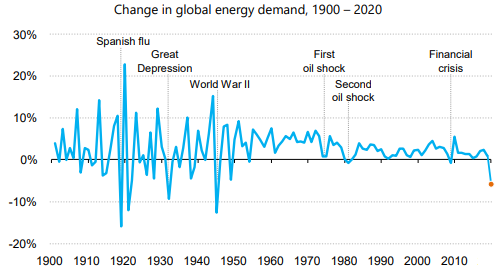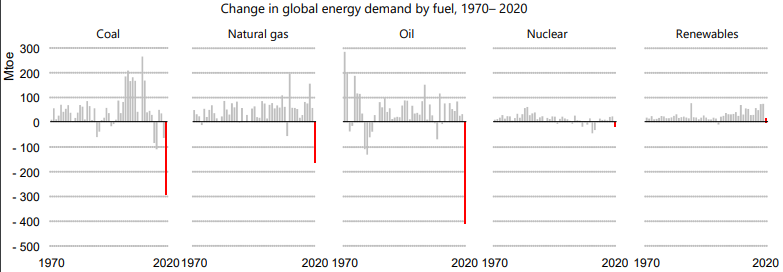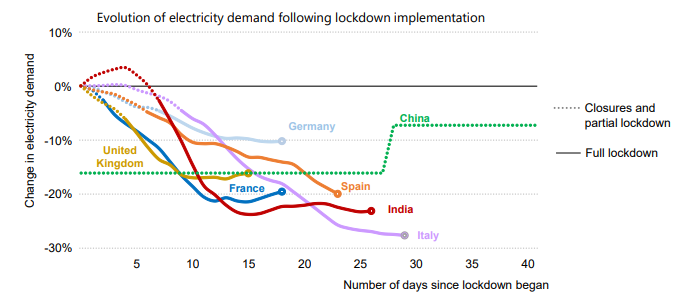The International Energy Agency (IEA) expects global energy demand to drop by 6 percent this year, global carbon dioxide emissions to fall by 8 percent, and renewable energy to be the only fuel that shows an increase in worldwide electricity production. According to the IEA, the coronavirus pandemic is a once in a century event for energy demand. Based on an analysis of more than 100 days of real data so far this year, the IEA’s Global Energy Review provides expectations for how energy consumption and carbon dioxide emissions trends are likely to evolve over the rest of 2020.

Global Energy Demand
IEA expects the shock to energy demand in 2020 to be the largest in 70 years, with global energy demand declining by 6 percent—a decline seven times greater than the 2009 financial crisis. Global coal demand is being hit the hardest, having falling by almost 8 percent in the first quarter of 2020 compared to the first quarter of 2019. Coal’s global decline in the first quarter was due to China’s drop in energy demand from the outbreak of the coronavirus, the continued displacement by inexpensive natural gas and renewable energy in the generation market, and mild weather. IEA expects coal demand for the year to decline by 8 percent due to a decline in electricity demand of nearly 5 percent.
Global oil demand was down almost 5 percent in the first quarter of 2020 due to the curtailment in driving and airline flights, which account for almost 60 percent of global oil demand. Global transport demand during the first quarter of 2020 was nearly 50 percent below its 2019 average and global aviation demand was 60 percent less. IEA expects oil demand to decline by 9 percent (9 million barrels per day) for the 2020 year—returning global oil consumption to 2012 levels.
Global natural gas demand was hit less—by just a 2 percent drop. It may fall much further in 2020 due to reduced demand in power and industry applications.

Global electricity demand was reduced during the first quarter 2020 by at least 20 percent during periods of full lockdown in several countries, as increases in residential demand are far outweighed by reductions in commercial and industrial demand. IEA expects global electricity demand to be down by 5 percent for the year and 10 percent in some regions.
Global renewable energy was the only source that increased demand in the first quarter 2020 due to growth in installed capacity and government-directed priority dispatch. Priority dispatch is the obligation on transmission system operators to schedule and dispatch energy from renewable generators ahead of other generators as far as secure operation of the electricity system permits. IEA expects renewable demand to increase for the year because of low operating costs, preferential treatment for dispatch, and continued growth in capacity driven by government subsidies and mandates. Generation of all other sources of electricity, including coal, natural gas and nuclear power, fell in the first quarter of 2020 and are expected to decline for the year.

Global Carbon Dioxide Emissions
Global carbon dioxide emissions are expected to decline by 8 percent (about 2.6 gigatons)—to around the levels of 10 years ago. Such a year-on-year reduction would be the largest ever, six times larger than the previous record reduction of 0.4 gigatons in 2009—caused by the global financial crisis —and twice as large as the combined total of all previous reductions since the end of World War II. IEA warns that the rebound effect after economies return to more normal conditions will result in carbon dioxide emissions returning to pre-coronavirus levels as people around the world go back to work.
Conclusion
IEA is forecasting a dismal year for global energy demand due to the coronavirus outbreak with it declining by 6 percent for the year. Global carbon dioxide emissions are expected to fall by 8 percent in 2020 due to the reduction in energy demand. The only fuel category to increase its output is renewable energy because of its priority in electricity dispatch and continued growth in capacity coming on line.



